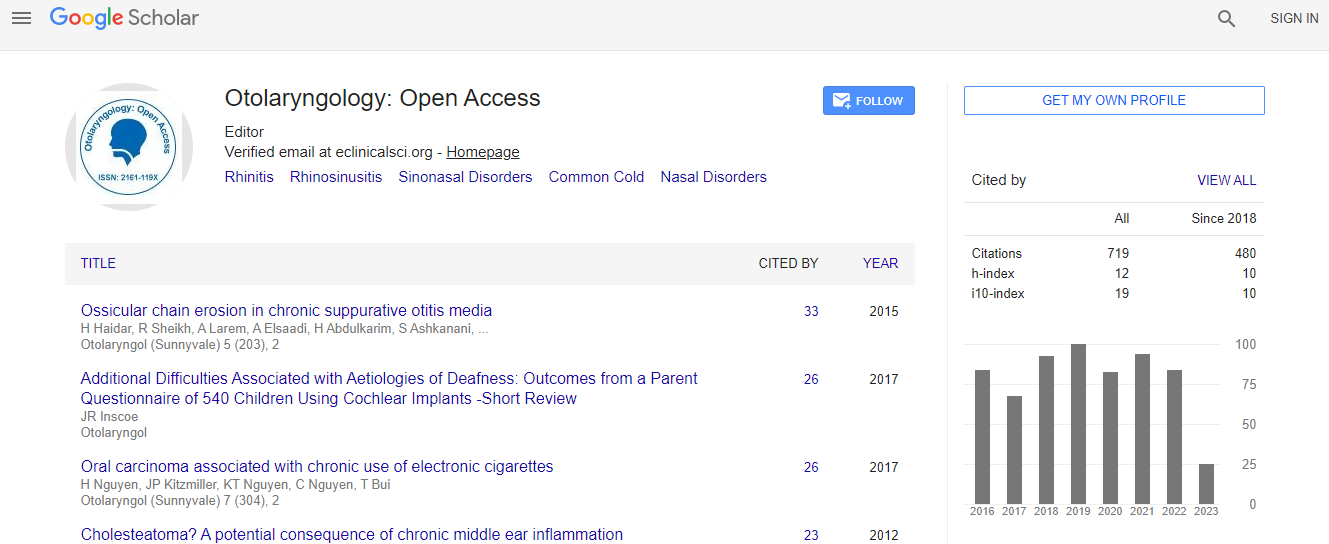Our Group organises 3000+ Global Conferenceseries Events every year across USA, Europe & Asia with support from 1000 more scientific Societies and Publishes 700+ Open Access Journals which contains over 50000 eminent personalities, reputed scientists as editorial board members.
Open Access Journals gaining more Readers and Citations
700 Journals and 15,000,000 Readers Each Journal is getting 25,000+ Readers
Google Scholar citation report
Citations : 925
Otolaryngology: Open Access received 925 citations as per Google Scholar report
Otolaryngology: Open Access peer review process verified at publons
Indexed In
- Index Copernicus
- Google Scholar
- Sherpa Romeo
- Open J Gate
- Genamics JournalSeek
- RefSeek
- Hamdard University
- EBSCO A-Z
- OCLC- WorldCat
- Publons
- Geneva Foundation for Medical Education and Research
- ICMJE
Useful Links
Recommended Journals
Related Subjects
Share This Page
The combined influence of nitrates in drinking water and radiation on incidence of childhood thyroid cancer in Belarus after the Chernobyl accident
Global Summit and Medicare Expo on Head & Neck Surgery
Valentina M Drozd1, 6, Vladimir A Saenko2, Alina V Brenner3, Vladimir Drozdovitch3, Vasilii I Pashkevich4, Anatoliy V Kudelsky4, Yuri E Demidchik1, Igor Branovan6, Nikolay Shiglik6, Tatiana I Rogounovitch2, Shunichi Yamashita2, Johannes Biko1, 7 and Christoph Reiners1,7
1Project Chernobyl, USA 2Nagasaki University, Japan 3National Cancer Institute, USA 4National Academy of Sciences, USA 5Belarusian Medical Academy for Postgraduate Education, USA 6The International Fund �Help for Patients with Radiation-Ind
ScientificTracks Abstracts: Otolaryngol (Sunnyvale)
Abstract
Recent epidemiological studies provide significant evidence that the worldwide rise in thyroid cancer incidence is not only due to more intensive screening diagnostics, but also suggest that an environmental factor could be also at play. Focusing on the experience of diagnosis of post-Chernobyl pediatric thyroid cancer in Belarus, we reviewed evidence of the effects of radiation, thyroid screening, iodine deficiency and content of nitrate in groundwater on regional differences in incidence rates of thyroid cancer. Previous studies have shown that chronic exposure to high levels of nitrate, similarly to the effect of iodine deficiency, might result in the development of goiter through TSH stimulation. There are other plausible mechanisms for associations between nitrate exposure and thyroid function as well as thyroid cancer in humans through endogenous formation of N-nitroso compounds that may act as the carcinogens. In Belarus, between 1960 and 1990, the use of nitrogen fertilizers increased 20-25 times from 4 to 92 kg/hectare, and the average level of nitrate in ground water increased from 1.1 to 41.6 mg/L. According to the Belarusian Ministry of Health, the proportion of pipeline water samples with nitrate concentration exceeding the WHO-recommended Maximum Contaminant Level (MCL) of 45 mg/L is about 1%. In contrast, about 40% of water samples from open wells have nitrate concentration exceeding the MCL. In Brest and Gomel Oblasts, the proportion of such samples reaches 40-60%, while in Mogilev Oblast, it is about 20%. Statistical analysis demonstrated that the effect of radiation on incidence of thyroid cancer significantly varied according to nitrate concentration (P=0.004). We propose that radiation effect might be modified by or depend upon the level of nitrates in drinking water. There is a need for analytic epidemiological investigation designed to evaluate a joint effect of nitrate exposure and radiation on risk of thyroid cancer. Such integrative approach may provide useful insights into the etiology and management of thyroid cancer.Biography
Valentina M Drozd is a Doctor of Science, author of more than 270 research papers and 7 monographs published in USA, Germany, Japan, Russia and Belarus. She has more than 25 years of research experience in medical issues related to the Chernobyl accident and radio induced thyroid cancer. She works as Professor in Endocrinology Department at Belarussian Medical Academy for Postgraduate Education, Minsk, Belarus since 2003 at International Fund “Help patients with radio induced thyroid cancer”, Minsk, Belarus, since 2004 and at Project Chernobyl, New-York, USA since 2007.
Email: vm.drozd@gmail.com

 Spanish
Spanish  Chinese
Chinese  Russian
Russian  German
German  French
French  Japanese
Japanese  Portuguese
Portuguese  Hindi
Hindi 
